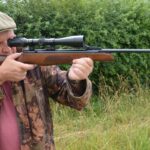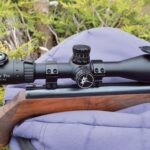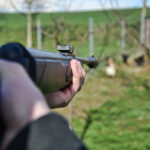Accuracy and precision are two key factors in shooting at any distance and with any firearm. A distance of 300 yards isn’t far enough yet to be considered ‘long range’ shooting, but it is farther than a lot of people are used to. At 50 or 100 yards mistakes and shooting errors aren’t as glaring. Without the proper knowledge and tools, at 300 yards you might be off the paper entirely, or at least far from the center. So, today we will be discussing rifle distances, scopes, tips for selecting good rifle optics for 300 yards, and shooting tips to remain effective at this distance.
Table of Contents
Understanding the Challenges of Shooting at 300 Yards
To make informed decisions about the right 300 yard rifle scope first, we have to respect that this isn’t just backyard shooting. At 300 yards mistakes are a big deal, and the scope you choose should be considered with the same level of seriousness. Let’s discuss the challenges of hitting targets at 300 yards and beyond, and how the right rifle scope can be the difference-maker.
Bullet Drop
Bullet drop refers to the projectile’s descent due to gravity. At 300 yards you can expect to see the following.
- A .308 caliber round will drop roughly between 10-12 inches (depending on specific load, conditions, and ballistic coefficient of the round).
- A 6.5 Creedmoor will see a drop of around 7-9 inches.
- A 5.56 round experiences a drop of approximately 11-13 inches.
Wind Drift
Another factor to reckon with is wind drift — the sideways motion of a bullet caused by crosswinds. Ballistic coefficients tell us how aerodynamically efficient a bullet is, which becomes more relevant as we shoot farther. The higher this coefficient, the less the bullet will be affected by wind drift.
For a 7 mph crosswind at 300 yards:
- A .308 caliber round will drift by about 10-12 inches.
- A 6.5 Creedmoor will drift around 7-9 inches.
- The 5.56 round will experience a wind drift of approximately 9-11 inches.

Target Visibility
It’s basic logic: the farther the target, the harder it is to see clearly. When you’re aiming at 300 yards, being able to discern your target clearly becomes more important. A good rifle scope will not only offer magnification to bring the target into closer focus but also have clear glass that give a crisp image.
A jump from 100 to 300 yards in shooting is no small feat. Bullet drop, wind drift, and target visibility are challenges that shooters must navigate. However, with the right rifle scope hitting targets at 300 yards becomes far more achievable.
Considerations Of 300 Yard Scopes
When selecting a rifle scope for long shots, understanding specific scope features will guide you towards making a choice in deciding what a good rifle scope for 300 yards will be.

Magnification Range
Magnification is a key factor in providing a close-up view of your target. For 300 yards, a magnification range between 5x and 12x is considered suitable. It provides a clear view of the target while maintaining a decent field of view (FOV) to observe surroundings, helping shooters aim precisely and also track moving targets or changing conditions swiftly. Semi-auto shooters are sometimes concerned about being able to quickly acquire targets for closer shots, and many elect to add an offset red dot on a rifle mount for quick close-range shots.
Objective Lens Diameter
The objective lens of a rifle scope determines how much light the scope allows to influence the brightness and clarity of the image. A larger objective lens enables more light, rendering a brighter and clearer image, especially in low-light conditions. However, be mindful of the size and weight it adds to your setup, as a larger lens can be bulkier.
Reticle Type
A reticle, or “crosshairs” help a shooter select their point of aim. For 300-yard shooting, a Bullet Drop Compensator (BDC) reticle can be beneficial as it provides holdover points to account for bullet drop at various distances. Alternatively, a Mil-Dot reticle provides dots along the x and y-axes. These can be used to estimate distances and holdovers, aiding in adjusting for windage and bullet drop more dynamically.
Adjustment Turrets
Adjustment turrets are knobs on a scope that allow you to modify the reticle’s position for windage (horizontal) and elevation (vertical) to sight in your rifle scope at your desired distance. These shouldn’t be changed for windage and elevation of a single shot like in the movies.
Optics Quality
High-quality glass characterized by clear, sharp, and bright images, makes a huge difference in seeing at distances. Look for scopes with lenses that have coatings to reduce glare and enhance light transmission. Superior optical quality reduces eye strain and provides a clearer sight picture, which becomes more important as distance increases.
Durability
Your scope needs to be durable enough to withstand recoil and weather elements. Seek scopes that are fog-proof, and constructed with materials like aircraft-grade aluminum to provide longevity and reliable performance such as the Apex Falcon V2 LPVO Scope.
Eye Relief
Eye relief pertains to the distance from your eye to the scope’s ocular lens while still providing a full-sight picture. Too much or too little eye relief causes scope shadowing.

It also protects your eye from ‘scope eye,’ or ‘scope bite’ which happens when the gun recoils and your eye is too close. It doesn’t feel good… I’m told.
Generally, an eye relief of at least 3.5 inches is considered safe and comfortable for most shooters with a more powerful rifle. Eye relief usually decreases as magnification increases, it is important to select the right picatinny mount for your scope.
Find The Right Scope For Your Long-Range Rifle
In selecting a proper 300 yard rifle scope you have to make sure it is compatible with your rifle. Many scope reticles on the market that compensate for bullet drop are caliber-specific and not interchangeable. So be sure to do your research or you may find yourself with an expensive scope that you cannot use.
Calibers For 300 Yard Rifle Scopes
Each caliber has different external and terminal ballistics which should be considered. For example, of the three calibers we have been discussing 6.5 Creedmoor has the highest ballistic coefficient. BC is part of the external ballistics of the round and dictates why it is less affected by external factors.
. A few popular calibers for 300-yard shooting include:
- .308 Winchester: Known for its accuracy and versatility, the .308 Winchester has a relatively flat trajectory, which means it doesn’t drop as quickly at longer distances. It also delivers good energy and is less affected by wind, making it a popular choice for long-range shooting.
- 6.5 Creedmoor: The 6.5 Creedmoor is highly regarded for its long-range precision. It combines a high ballistic coefficient with low recoil, allowing for accurate shots well beyond 300 yards. It’s known for maintaining velocity and energy at extended ranges.
- 5.56 NATO: While the 5.56 NATO is not typically associated with extremely long-range shooting, but is still very effective at 300 yards and beyond, especially with the right barrel twist rate. It’s lightweight, which reduces recoil, and it’s readily available, making it a budget-friendly option for intermediate-range shooting.

Each of these calibers has its own ballistic profile, influencing aspects like bullet drop and wind drift at 300 yards, which should inform your choice of scope and reticle. The terminal ballistics of each round should also be considered based on your goals for the firearm. Terminal ballistics is the study of what happens to a projectile, such as a bullet, upon impact with a target.
Selecting Reticle For 300-Yard Shooting
The reticle is essentially your aiming point within the scope, and choosing a type that complements your shooting style and the ballistics of your caliber goes a long way to increase precision with distance.
BDC Reticles
Bullet Drop Compensator (BDC) reticles feature holdover points that visually represent bullet drop at varied distances, making it easier to quickly adjust your aim for long shots without needing to make any rifle scope adjustments. BDC reticles are calibers and bullet weight specific so choose one that aligns with your shooting profile.
Mil-Dot Reticles
Mil-Dot reticles are another fantastic option for long-range shooting. They feature dots along the crosshairs that represent specific distances (in milliradians) and can be used to estimate the distance to your target and adjust for both bullet drop and windage. This type of reticle allows for swift adjustments and is popular among military, tactical shooters, and hunters.

Illuminated Reticles
Illuminated reticles incorporate adjustable lighting into the reticle design. This helps visibility in low-light conditions – like during dawn or dusk, or in heavily shadowed areas.
This enhancement can significantly improve sight picture and target acquisition when natural lighting is suboptimal. However, don’t forget to swap out batteries, or bring extra on your hunting trip.
Looking for a scope that really does the job?
The Tacticon Armament Falcon V3 it a dedicated rifle scope that features an illuminated reticle that allows you to choose between red, green, and blue. The different color choices allow the scope to be more adaptable in different environments. With a 3x-9x range the scope is very capable at 300 yards, and the Mil-dot reticle assists shooters with hold overs for distance and wind drift. The scope comes in at a very affordable price, right around $150, and can be used for a variety of calibers.
Tips To Improve 300-Yard Shooting Performance
Effective shooting at 300 yards doesn’t only depend on choosing the right rifle scope, accounting for wind drift, and bullet drop. It also heavily relies on your shooting techniques, understanding of environmental factors, and knowledge about the ballistics of your chosen caliber. Let’s discuss some aspects that can fine-tune your 300-yard shooting abilities.
General Shooting Tips
There’s no replacement for proper shooting technique. Even minor inconsistencies in your shooting fundamentals are magnified over longer distances, transforming what might be negligible at 100 yards into a significant miss at 300 yards. Here’s a closer look at some general tips:
- Trigger Pull: A smooth, consistent pull avoids disturbing the rifle’s position during firing.
- Breathing: Pause your breath while squeezing the trigger to reduce movement.
- Steady Shooting Position: Establish a stable position, ensuring that the rifle is well-supported and your body is relaxed. A minor error in any of these can result in a several-inch deviation at 300 yards, whereas the impact would be minimal at closer ranges like 100 yards.
Adjustment Factors
- Wind Reading: Understanding how to read the wind and compensate for its effect on your projectile makes a big difference. Wind can push your bullet off course, and its impact is more pronounced at 300 yards. Look for tall grass, leaves, really anything that moves to help estimate wind speed.
- Range Estimation: Accurate range estimation is key to compensating for bullet drop. Mil dot and BDC reticles will help with this. Range finders are also very useful. Don’t forget your analog skills though. In the movie Jarhead, Jamie Foxx asked his Marines how he knew the target was 300 yards away. One Marine replied “Three football fields, Sir.” When in doubt, use what you know.
Ballistics
Understanding the ballistic characteristics of your chosen caliber and ammunition is a fundamental piece of compensating for bullet drop and wind drift. The difference in bullet drop from a 55gr FMJ and 77gr OTM 5.56 round is about 4 inches at this distance, with the 77gr having less drop due to its higher ballistic coefficient.
Final Notes
Successful shooting at 300 yards comes down to marksmanship fundamentals first and foremost. After this having an accurate rifle is the next essential. Without these two there is no way to consistently make accurate shots.
A good scope will both increase accuracy and consistency once these two pieces are in place. For 300 yards it is best to have a scope with a way to compensate for environmental factors tailored to the caliber of the rifle.
Proper magnification between 5x-12x will greatly increase visibility and accuracy by making it easier to aim. Look for a scope with crisp, clear glass and keep it clean so it will serve you for years to come.
The opinions expressed in this post are those of the author and do not necessarily reflect the views and opinions of Tacticon Armament.











































